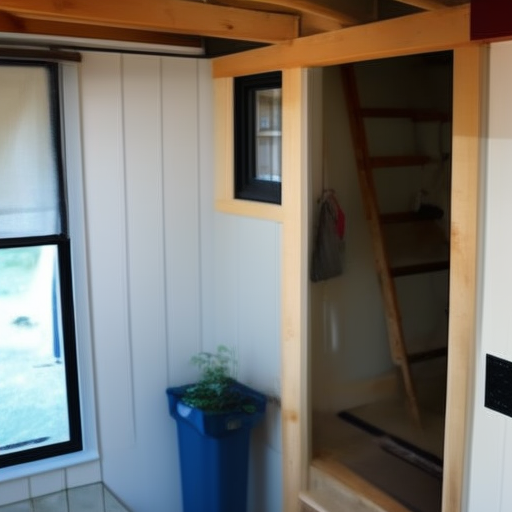Living in a tiny home can be quite the challenge in and of itself; however, when you add in unbearably humid conditions due to lack of airflow, it can become quite unbearable. Feel like you’re just waiting for the summer storms to roll in and bring relief to the humidity? Fear no more! We’ve got the perfect guide to help you lower the humidity in your tiny house. With the right equipment and a few simple tips, you’ll soon be able to create a comfortable and enjoyable atmosphere in your small home, free from uncomfortable humidity. So let’s get started!
Identifying High Humidity Areas
One of the biggest culprits of high humidity in a tiny house is the bathroom. Taking a long, hot shower can leave the bathroom damp and humid for hours afterward. This can lead to mold growth, which not only smells bad but can also be detrimental to your health. Another common area where humidity can run rampant is the kitchen. Boiling water, cooking meals, and using the dishwasher can all contribute to excess moisture in the air.
If you’re having a hard time identifying where the humidity is coming from, try using a hygrometer. This handy device measures the level of moisture in the air and can help pinpoint which rooms in your tiny house are the most humid. You can find them online for as little as $10. Once you know which areas have the highest humidity levels, you can start taking action to reduce the moisture in the air. Some ways to do this include running a dehumidifier, improving ventilation, and drying wet surfaces promptly.
Reducing Humidity Through Ventilation
One way to effectively reduce the humidity levels in your tiny home is by ensuring adequate ventilation. This means creating a healthy flow of air inside your space, which can help eliminate dampness and prevent mold growth. Ventilation is particularly useful during summer and winter when the temperatures outside fluctuate drastically from inside.
An easy and practical way to ventilate your tiny house is to open windows and doors to allow air to circulate. Additionally, you can install an exhaust fan or an air conditioning system to regulate humidity levels by circulating air inside your living space. Installing a dehumidifier is another option, especially in areas with high humidity levels. A dehumidifier works by absorbing excess moisture from the air, which can improve air quality and prevent respiratory problems. Remember, good ventilation is critical in reducing humidity levels and improving the air quality of your tiny home.
Using a Dehumidifier
Dehumidifiers are effective tools that can lower the humidity levels in your tiny home. They work by drawing in moisture from the air in your living space and collecting it in the water tank. The collected water can then be emptied regularly, which helps keep your home dry and free from mold and mildew.
When choosing a dehumidifier, consider the size of your living space and the level of humidity you need to combat. Most dehumidifiers come with a built-in humidistat that can help you monitor the humidity levels and adjust settings accordingly. To maximize the efficiency of your dehumidifier, it is important to place it in a central location in your home, away from walls or furniture that might restrict airflow. Once you turn it on, you’ll notice the difference within a few hours, as the air becomes fresher, cooler and more pleasant.
**Tips for :**
– Clean your dehumidifier regularly to keep it working efficiently
– Use it during the warm or rainy season, when humidity levels tend to be higher
– Set the humidistat to a comfortable level, around 50% to 60%
– Place it in a central location in your tiny home, away from walls and furniture
– Empty the water tank when it’s full to prevent spilling and ensure maximum efficiency
Remember that dehumidifiers can be noisy, so it’s important to consider the noise level when choosing a unit. The good news is that technology has improved and there are now dehumidifiers with advanced technology that are quiet, even at full blast. So, if you’re struggling to keep your tiny home cool and fresh, it’s time to invest in a reliable dehumidifier – the difference it can make to your quality of life is remarkable!
Lowering Humidity without an Appliance
One simple way to lower the humidity in your tiny home is by using natural methods. First, try opening windows and doors to allow for air flow. This will increase ventilation and prevent moisture from accumulating. If you don’t have windows, consider adding roof vents or a skylight to create a natural airflow.
Another great natural solution is to use silica gel packets. These are small, porous packets filled with silica gel that absorb moisture. Simply place them in areas prone to humidity, like your bathroom or closet. You can reuse these packets by placing them in an oven at a low temperature to dry them out. This technique is great because it’s cost-effective, eco-friendly and easy to implement. Gone are the days of damp, sweaty walls and musty odors! By reducing humidity in your tiny home, you can look forward to more comfortable and healthy living conditions. With a few strategic investments, you can easily make your tiny home much more livable, without sacrificing too much of your time or resources. Lowering the humidity has never been easier!